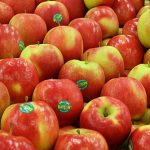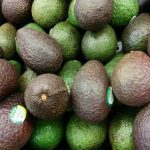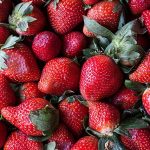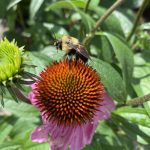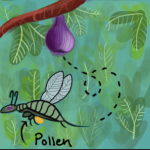Overview:
Flowers are some of the most beautiful and recognizable structures that plants make. But why do they make them? The simple answer is for reproduction: flowers produce seeds to make more of that species of plant.
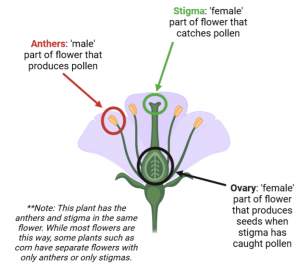
Figure 1: Diagram of basic flower parts.
This is done through the transfer of pollen from the anthers (male reproductive part) of a flower to the stigma (female reproductive part) of a flower, which is a process known as pollination. The completion of this process allows for the creation of seeds which can then grow into new plants.
Methods of Pollination:
There are a variety of ways that the pollen can be transferred to get from the anthers to the stigma. One way is by wind, such as the ‘dust’ of pollen grains coming off the corn plants in Figure 2:
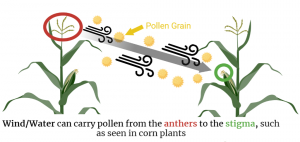
Figure 2: Diagram of wind pollination in corn plants.
Many plants that make flowers (around 90%, in fact [1]! ) use the help of insects and animals such as bees and birds, as seen in Figure 3, to carry the plant’s pollen from one flower to another:
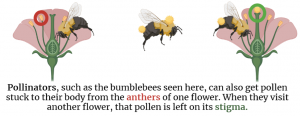
Figure 3: Diagram of bee-assisted pollination.
Pollination by a pollinator has many advantages for plants. Instead of hoping their pollen gets blown where it needs to go, pollinators can help ensure the pollen travels to another flower. This way, the plant can have more successful pollination events and so can produce more seeds. Also, pollinators help ensure that pollen is transferred between different flowers on different plants. This helps give the species more diversity of individuals since the genes in the created seeds are mixed from two distinct plants instead of just from one.
Pollination In Your Life:
Why should you care about pollinators? Well, chances are that many of the foods you eat rely on their pollen carrying abilities. Have you eaten any apples, strawberries, avocados, or chocolate (cocoa) lately? These fruits are produced by the plant to help protect the seeds after pollination. These are just a few the plants that require pollinators to help transfer pollen so the flower can produce the edible fruit we use as food [2]. In fact, over one-third of the plants we eat rely on pollinators to allow them to produce their fruits [3].
Also, studies have shown that by protecting pollinator habitats, we also help reduce pest bug populations and protect our soil and water quality [4]. To find out ways that you can help protect pollinators in your backyard, check out things you can do to help!
I’ll Help You If You Help Me:
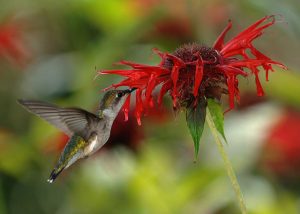
Figure 4: A ruby-throated hummingbird sipping nectar from scarlet beebalm. Notice how the flower makes a perfect tube for the hummingbird’s beak to fit in!
Pollination is not done out of the goodness of a pollinator’s heart, however. They have to get something out of it. Many times, this is in the form of a sugary nectar drink the plants make that attracts insects and birds. While eating their sugary meal, the insects and birds get pollen from the flower attached to them and then carry it to a new flower as they leave to find more of the sugary liquid. These relationships are known as mutualisms because both the plant and pollinator get something from it: the plant gets help transferring its pollen while the pollinator gets a sugary meal. The mutualisms between plants and pollinators have been around for a very long time, since at least 90 million years ago [5]!
Since these plant-pollinator relationships have been around for so long, some species of plants have evolved ways to attract specific pollinators. Through changing things such as flower shape, color, and size, plants can gain the help of certain pollinators that will almost exclusively visit their flowers [6]. Check out the webpages linked below to see some local examples of this as well as some extreme examples of relationships between plants and their pollinators!
Check out Local Species and Their Pollinators to learn about some of the plant-pollinator mutualisms seen here in our pollinator gardens!
Check out Cool Pollinator-Plant Relationships to learn about extreme examples of plant-pollinator mutualisms!
Footnotes:
[1] Ollerton, J., Winfree, R., and Tarrant, S. (2011) How many flowering plants are pollinated by animals? Oikos. 120, 321–326
[2] Ritchie, H. (2021) How much of the world’s food production is dependent on pollinators? Our World in Data. [online] https://ourworldindata.org/pollinator-dependence (Accessed November 30, 2021)
[3] Randall, B. (2020) The Value of Birds and Bees. USDA Farmers.gov. [online] https://www.farmers.gov/blog/conservation/value-birds-and-bees (Accessed December 1, 2021)
[4] Wratten, S. D., Gillespie, M., Decourtye, A., Mader, E., and Desneux, N. (2012) Pollinator habitat enhancement: Benefits to other ecosystem services. Agriculture, Ecosystems & Environment. 159, 112–122
[5] Crepet, W. L. (2008) The Fossil Record of Angiosperms: Requiem or Renaissance?. Annals of the Missouri Botanical Garden. 95, 3–33
[6] Ollerton, J., Alarcón, R., Waser, N. M., Price, M. V., Watts, S., Cranmer, L., Hingston, A., Peter, C. I., and Rotenberry, J. (2009) A global test of the pollination syndrome hypothesis. Annals of Botany. 103, 1471–1480
Figure Credits:
Figures 1, 2, and 3 created by ADM using BioRender.com
Fruit images by Toby Hudson, Susan Slater, and Tomas Castelazo on Wikimedia Commons
Figure 4 by Joe Schneid on Wikimedia Commons
 ADM made this page to increase plant appreciation as a part of Wooster’s Field Botany course in Fall 2021.
ADM made this page to increase plant appreciation as a part of Wooster’s Field Botany course in Fall 2021.
